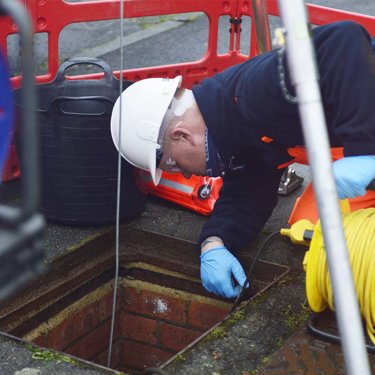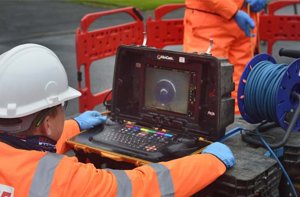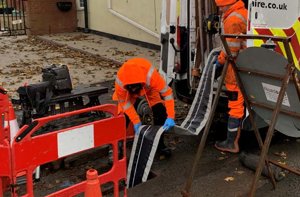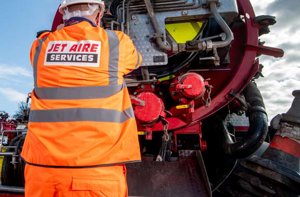
Cleaning and maintenance
We help customers to maintain their drainage infrastructure by providing a range of cleaning and waste disposal services to clear blockages, improve efficiency and rectify issues before they escalate into more serious and costly problems.
We work both reactively and proactively, responding quickly to flooding, odours or other visible signs of an issue and defects identified by investigative surveys as well as carrying out routine maintenance to keep pipes and drains flowing smoothly.
Our team has 30 years of experience dealing with drainage issues. We are trained in confined space entry and high-pressure water jetting and have the advanced equipment to deal with blockages of any sort.
Benefits
- Fast, reactive service to tackle issues.
- Trained to work in confined spaces and with high-pressure water jetting.
- Experts in blockage clearance.
- Nationwide coverage.
Added value
Experience
Equipment
Efficiency
Cost savings
Trusted
Blockage clearance
Blockages can be caused by a build-up of debris such as fats, oil and grease (FOG), root ingress or structural issues and can occur at any point in the drainage network. Pipes, culverts, gullies, surface water drains, tanks and pumping stations can all be affected.
We will identify the type of blockage using CCTV cameras and use the most appropriate equipment to clear it quickly and effectively, restoring optimum flow whilst minimising disruption, the need for excavation and environmental impact.
The right equipment
Our high-pressure water jetting equipment and specialist attachments can remove any kind of blockage from any type of pipe, including root intrusion, concrete deposits, bricks, grout, FOG, silt, chemical residues, and rust.
The matter is broken down, flushed through the system to the next manhole and removed via a vacuum pump.
Our equipment includes:
- High-performance jet-vac tankers to tackle pipes of any diameter.
- Recycler units to continually clean and reuse jetting water, reducing time on site, and minimising environmental impact.
- Ultra-high-pressure recycler with stronger suction of 1850 CFM and beyond.
- All-terrain vehicles (remote reels) to allow access to hard-to-reach areas such as woodland, steep gradients and over poor ground conditions.
- Mechanical removal of obstructions including chain flails for removing roots, milling cutters for removing concrete, avature heads for removing scaling, bulldogs for removing fat and grease, de-silt bombs, culvert cleaners and grenade bombs.
Section 104 cleans
We undertake thorough pre-adoption cleans of pipes and manholes to ensure they are free from snagging points prior to handover. We jet from manhole to manhole across the site and follow up with a CCTV survey and WinCan report to show lines are clear and make remedial recommendations.
Syphon cleaning
Syphons usually run under rivers, railways or roads and present specific maintenance challenges.
Partial syphon blockages reduce hydraulic capacity and place unnecessary pressure on the system whilst a total blockage or failure can cause extensive environmental and reputational damage. Therefore, investing in routine clearance can prevent massive expenditure down the line.
We isolate the pipe by diverting the flow into a secondary pipe or via pumps, bridges or even tankering, if it is a single-line syphon, before removing silt and other debris.
Planned preventive maintenance
When pipes and drainage systems are not regularly cleaned debris can build up, causing a reduction in flow and blockages. This can lead to flooding and other problems which can cause closures and be inconvenient and costly to resolve. Our programmes of planned preventive maintenance (PPM) consist of carrying out regular cleanses and drain surveys of pipes, culverts, sewers, drains and tanks to prevent more expensive drainage issues arising in the future. We also empty grease traps and carry out gully cleaning.
Industrial tank cleaning
We provide tank and interceptor inspection and cleaning services to help customers avoid leaks, spills, contamination, pollution, or degradation, and remain compliant.
In line with regulations, we remove all waste and ensure filters, sensors and surrounding areas are thoroughly cleaned, as well as checked to ensure the unit remains in good working order.
Our team is highly experienced in the maintenance of all types and sizes of industrial tanks, working safely and efficiently to minimise downtime for businesses and organisations.
We provide tank cleaning for the following:
- storage tanks
- processing tanks
- mixing tanks
- chemical silos
- water tanks
- transportation tanks
- digesters
- fuel tanks
- break tanks
Our expertise covers:
- Vessels and interceptors manufactured from steel, concrete or reinforced plastics and fibreglass.
- Complex and challenging industrial cleaning projects, including tanks containing hazardous chemicals or substances.
- Servicing tanks involving structures above or below ground, including lagoons.
- Cleaning and maintenance of associated pipelines, sewers and culverts.
Industrial tank cleaning can be carried out in two ways, remote cleaning (non-entry) and confined space entry. We will assess the most suitable method based on the type of tank and the substance to be cleaned.
Remote cleaning uses a range of equipment suitable for the specific needs of the tank. This option can be carried out through high-pressure water jetting, shot blasting and pumps as well as 3D Head technology and tracked robotics with suction hose attachments.
If remote cleaning is not possible, our fully-trained engineers will carry out carefully planned confined space entry. There are different categories of confined space entry, from low to high risk and we are experienced operators in all environments.
You might also be interested in...
Here to keep your drainage flowing freely
Our experts are available to quickly diagnose issues, provide cost-effective solutions, and carry out routine maintenance to get your drainage network back to normal as soon as possible.
Speak to our experts




